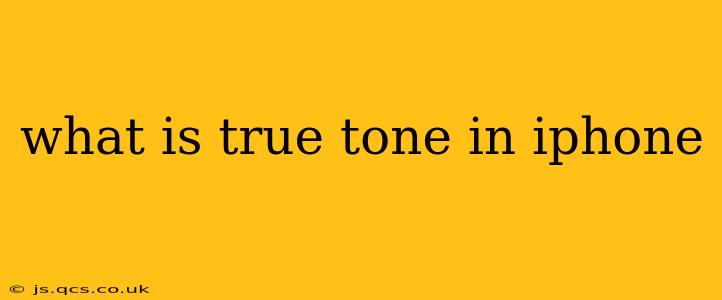True Tone is a display technology feature found on many iPhones and iPads. It dynamically adjusts the white balance of your screen to match the ambient lighting conditions in your environment. This results in a more comfortable and natural viewing experience, regardless of whether you're indoors under warm lighting or outdoors in bright sunlight. But how does it work, and is it worth using? Let's delve deeper.
How Does True Tone Work?
True Tone utilizes the ambient light sensors already present in your iPhone or iPad. These sensors continuously monitor the color temperature of the light around your device. Based on this data, the True Tone technology subtly adjusts the white point of your screen. This means it modifies the balance of red, green, and blue light to create a more neutral white that complements the surrounding environment. The effect is subtle, but noticeable, resulting in a display that feels more natural and less harsh on your eyes, especially during extended use.
Is True Tone Always On?
By default, True Tone is enabled, but you can easily toggle it on or off in your device's settings. You'll find the setting under Display & Brightness, allowing for complete control over the feature. This gives users the flexibility to use it when they prefer a more natural display or turn it off if they prefer a consistent color temperature across different lighting environments.
What are the Benefits of True Tone?
The primary benefit of True Tone is improved eye comfort. By dynamically adjusting to the ambient light, it reduces eye strain associated with viewing a screen that's too warm or too cool in a particular environment. Many users find that True Tone makes the screen appear more natural and less jarring, particularly when switching between indoor and outdoor spaces.
Does True Tone Affect Color Accuracy?
While True Tone subtly adjusts the white balance, it doesn't significantly impact the overall color accuracy of your display. The adjustments are designed to be imperceptible in most applications and don't drastically change the colors you see in photos, videos, or games. However, some users might notice slight differences, especially when comparing the screen to a reference image under controlled lighting conditions. For professionals requiring highly precise color accuracy, like graphic designers or photographers, disabling True Tone might be preferable for color-critical work.
How to Turn True Tone On or Off?
Turning True Tone on or off is straightforward:
- Open the Settings app on your iPhone or iPad.
- Tap on Display & Brightness.
- Toggle the True Tone switch on or off.
Does True Tone Affect Battery Life?
The impact of True Tone on battery life is minimal and generally negligible for most users. The constant monitoring and adjustment required by the feature consumes a tiny amount of power, far outweighed by the benefits of enhanced viewing comfort.
How is True Tone Different from Night Shift?
While both True Tone and Night Shift affect the colors on your display, they do so in different ways. True Tone dynamically adjusts the white balance to match the ambient light, while Night Shift reduces the blue light emitted by the screen at night, making it warmer and easier on your eyes during nighttime use. You can use both features simultaneously. Night Shift is primarily designed for reducing blue light exposure before bed, while True Tone aims for better overall viewing comfort throughout the day.
Is True Tone Worth It?
For most users, True Tone is a worthwhile feature that enhances the overall viewing experience. The improved comfort and more natural-looking display generally outweigh the negligible impact on battery life. However, users with a strong preference for precise color consistency might prefer to keep it turned off. Ultimately, it's a matter of personal preference, easily toggled on or off based on individual needs and preferences.
